To start off, some douglasias. Douglasia nivalis, which sometimes flowers as early as January here(but not in these pictures), in a trough, and then D. montana in a not-so-great year.
Comments
"It must be a douglasia", I
"It must be a douglasia", I thought, "but which one?" So I sent a piece off to Tass Kelso, and she said it was probably a form of either nivalis or idahoensis, I forget which one.
I got so excited I decided to transplant the thing into one of the troughs with douglasias ....and that was the end of that.
Well, these things happen.
Well, these things happen.
My problem seems to be a peculiar obsession with starting seed... no, I should restate that... the obsession starts with OBTAINING seed, which is when my thinly-veiled greed comes roaring to the surface. Then starting seed is pretty obsessive too, given that I don't have unlimited space for planting (though, luckily - *ahem* - I kill enough each year to always have spaces). By the time I actually get to planting out what I've started, I'm often in the burnt-out aftermath where the former enthusiasm has waned, so it's, "Oh, god, how many more trays to plant? Look, there's an empty spot - let's just stick it in there. Uggh, can't be bothered to record where I planted it... I'm sure I'll remember what it was...". ;-)
But... your Douglasia are looking fantastic! I only have D. montana (and not grown particularly well), so it's very interesting to see your plants and how much the foliage varies between these species.
Aftercare is often a problem
Aftercare is often a problem here. Or was. I don't have much of anything else to do, these days, and so I go down into the laundry room every day, maybe twice a day, and look at the oncocyclus seedlings, and check the bags of seed for more signs of germination. So it seems as though this is taking forever.
Today, I made a place for the three flats of acorns I sowed (Quercus undulata), squirrel-proof behind hardware cloth, and washed a bunch of pots in preparation for sowing all the twenty-year-old seed I got. I'm still looking at Pavelka's seedlist, and thinking. (Already ordered from Stanek.)
I sowed more cactus seed, too, on the 25th. The first picture, which I may have already posted, and taken with the flash just now, so crummy, shows about 600 seedlings mostly from last year's sowing (some from the year before), and the second picture shows the seedlings that have emerged from the sowing on the 25th.
When people ask me what I'm going to do with all these plants, I just give them a blank look. What kind of question is that to ask a gardener?
Oh, by the way. I'm probably one of the few people who will admit that they killed the white form of Physoplexis comosa.
Always informative to follow
Always informative to follow your writings, Bob.
Are you overwintering your seedling cactuses in the warm?
I thought I would post this
I thought I would post this as a supreme example of my extremely dumb behavior......
The cactus seedlings are on tables in the upstairs bedroom, where they get afternoon sun. Grown in pure sand. (Germinated in a regular-type soilless mix, then transplanted into sand to avoid root rot.) I couldn't say if the cactus have shriveled in preparation for winter; it's often subtle in plants that small, but I assume they have, so I won't water them until spring.
Incidentally, the pots are B.E.F. Grower's Pots, made in the U.K., which I bought for about twenty-five cents each back about 1990 or so; they've been outdoors ever since, and are all still intact. Can be squeezed between thumb and forefinger, almost to meet in the middle, just like new. I understand the pots are no longer made, and now wish I'd bought hundreds in different sizes.
D. nivalis in the garden
D. nivalis in the garden today. They grow like weeds in the rock garden and make a prodigious amount of seed. Most of mine are done
flowering by early March.
Beautiful! What's the yellow
Beautiful! What's the yellow one to the left? Are those the seed pods of Oenothera (O. triloba??) surrounding it?
Lori, the seed pods come from
Lori, the seed pods come from a crummy tree that is in my yard. It manages to slowly loose its seedpods all winter long so i am constantly picking them up. The yellow flowers are some unknown Draba. These flower very early and provide sustenance to the pollinators when things are mostly not in bloom. As soon as the flowers fade i cut them all off, i have lots of this particular Draba and dont need any more, Same goes for most of the Astragalus and Oxytropis. The other Draba i grow, Draba densifolia seems to not have such rampant tendencies so i let them go on and seed around.
The crummy tree would be a
The crummy tree would be a sycamore. Trees with the right provenance barely make it up here in Minneapolis. I'm told they tend to get a fungal leaf disease, I think an anthracnose, that defoliates the trees in the summer. And then they leaf out again. Nice bark, though.
Jim, those plants are super happy!
I think the seed pods look
I think the seed pods look more like Liquidambar, the Sweetgum. The capsules are hard and can be used with pine cones in wreaths; the Sycamore fruit crumbles in a relatively short time. It's (Sweetgum) a beautiful tree for fall color and its droppings not a problem if you've got a shade garden where they fall and blend in with the mulch, but to have them raining down on an alpine bed cannot be much fun!
Oh! Very possible, in fact
Oh! Very possible, in fact probably yes, since I've never seen Sweetgum pods before. They don't grow here.
Lori, Bob, I thought I was
Lori, Bob, I thought I was the only one who a) has a backlog of over 600 varieties of seed for one measly suburban garden lot and b) after having binged on starting them, has to force myself to get them out of the starter flats before they choke to death, and c) looks desperately around for somewhere, anywhere, anyone to stick them in the ground before final freeze-up closes the gardens for another year. Whee, I'm not alone!
This year, I have many dozens of Primula seedlings on the go, a hundred or so species ranging from Adonis to Zauschneria in the fridge cold-stratifying, about a hundred species in starter flats busy germinating, plus ambitions to start another 200-300 spp. before they expire in their packets, many of them from the NARGS seed exchanges. Wish me luck!
I look forward to more pictures of your spring. Ours is late (-2 C high today, black ice and snow for the morning commute), but at least the Puschkinia will be in bloom come the next day above zero. And no, having them against a south-facing foundation is not cheating, it still counts as spring having sprung.
Alison,
Zone 5a, Ottawa, Ontario
Welcome to the Forum, Allison
Welcome to the Forum, Allison!
I classify myself as a mad propagator, too. Your local NARGS chapter plant sale (or any plant sale) is a useful way to unload your extra plant materials. I've been the major contributor for more than a decade for ours. Our spring and late summer sales are our only fund raisers.
I was gratified to read that
I was gratified to read that the late Christopher Lloyd would buy plants and then wander around Great Dixter looking for places to put them. Usually my first chosen place turns out to be the wrong one; I dug up the plant to put it in the "right" one, and then it dies.
I have 24 flats of pots outdoors, a flat of mesembs (aloinopsis, titanopsis, etc.) indoors, a thousand cactus seedlings, several dozen iris seedlings, and an ongoing astragalus germination project as well as an ongoing sclerocactus germination project. (I've posted pictures of the sclerocactus germination on Facebook). No idea where these plants are going to go.
I was planning to go to the cactus sale at DBG tonight, but when I type "a thousand cactus seedlings" that seems kind of overkill to me.
Never seen black ice. Heard about it.
The thing is that you don't
The thing is that you don't actually "see" black ice. ;-) Instead, you come upon it while driving, lose control, spin out, and hit the ditch at highway speed. (With luck, the ditch is full of snow to cushion the impact, and spin is accomplished without anything getting in the way!) That said, it's simply clear ice, that shows the colour of the substrate below, making it hard to detect (as opposed to white ice from compressed snow or slush).
So I've heard. I try not to
So I've heard. I try not to drive anywhere when there's weather. I read a lot, instead.
I also hear about things like rain falling, when there's snow on the ground (??), and morning dew, and "muggy weather", and plants that need "protection" in "wet winters" or "protection from summer rain" (??), and mysterious creatures called "slugs".

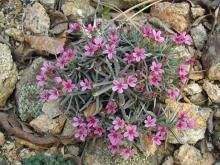
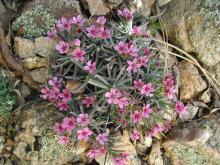
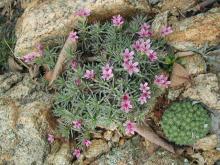
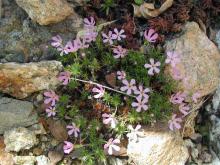
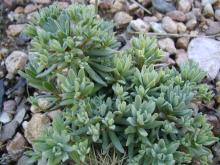
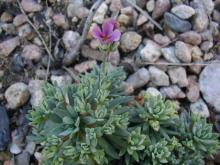
So anyway, there are douglasias in the troughs here. One year, this thing appeared in one of the raised beds. It had strangely succulent leaves, and I had no idea what it was, until it bloomed.